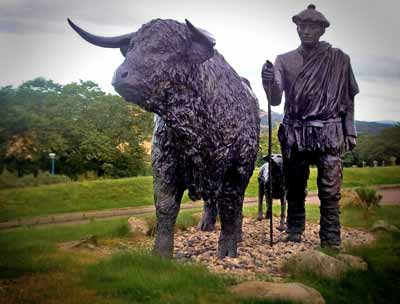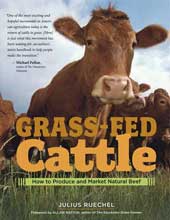How to spot reputable cattle breeders...

Image Credit: Dave Conner, Flickr, CC BY 2.0
So you've settled on a breed and you're ready to buy some cattle. But first you need to find a reputable cattle breeder. This article will show you how to identify first-class breeders and how to steer clear of the rest.
A good cattle breeder has a ruthless selection strategy not only when offering cattle for sale, but also when selecting breeding stock for their own herds. Only the most fertile and most efficient cattle are allowed to breed. Any animal that doesn't make the grade, regardless of its pedigree, is ruthlessly culled and reassigned to the feedlot or grass-finishing pasture.
My book Grass Fed Cattle: how to produce and market natural beef describes all the individual traits that reveal the most fertile and most efficient animals. A good cattle breeder relies on exactly these same traits.
And that means you should be able to spot plenty of obvious clues to help you separate the good from the bad breeders when you visit their farms and dig a little deeper into how they make their cattle breeding decisions. Let's have a closer look.
Beef Cattle Breeder Pedigrees and Award Shows
Pedigree matters, but only to prevent inbreeding. It's not a guarantee of performance.
Beware of breeders who are too focused on pedigrees and cattle show awards. These can easily impair their objectivity when it comes time to cull sub-par animals, especially if they've invested huge dollars on prize bloodlines or spent significant resources participating in a show circuit.
Never let a pedigree overrule the basic rules of a rigorous culling program based on fertility and feed efficiency.
Feed Trials
Focusing too closely on feed trials can be another dangerous trap.
Many breeders put their bull calves on intensive feed trials designed to show how many pounds of gain they are able to produce per day. They can show some very impressive numbers, but that's not actually a guarantee that those daily weight gains will also translate to the bull's offspring.
As I discuss in my book, the top gaining bulls in a feed trial may actually be winning the eating competition precisely because they are less fertile than their peers.
Furthermore, a feed trial during adolescence can overfatten a young bull at precisely the time when his reproductive equipment is developing. Fat in the testicles leads to lower fertility because the sperm overheat. A feed trial can impair a bull's fertility for life if he gets too fat at the wrong stage of his adolescent development.
Avoid pet cattle like the plague!
Beware of breeders whose cattle have become pets. It's pretty hard to send your favorite prize-winning hand-raised tame cow to the meat grinder just because you had to give her a bit of help to calve. But imagine what your calving season would look like if the bull calf you buy from this breeder passes those calving difficulties on to half your calves.
If you hear a breeder providing excuses why a cow with calving difficulties or poor feed conversion efficiency was allowed to remain with the breeding herd, run!
Who is the cattle breeder catering to?
It's also important to understand who the target buyers are. Not all beef cattle breeders are catering to the same audience.
When breeders cater to hobby enthusiasts looking for pets, the single-trait selection criteria used to create a certain look often comes at the expense of the health and adaptability of the animals. This is similar to the pitfalls that befall many dog breeds that are focused to closely on creating and maintaining a certain look.
You are in the business of producing beef. Breeders are in the business of producing pure-bred genetics for their customers. Breeders are vital to the the future of the cattle industry to preserve the pools of purebred genetics that beef producers draw from to build the perfect herds for their beef production programs. But understand that every breeder has a different target market.
Producing genetics that perform well in a pasture-based grazing system may not be the primary focus of their genetic selection process. Make sure you get to know your breeders and visit their farms to ensure that you both have the same goals in mind.
What to look for in a breeder:
Visit your cattle breeders' farms. A farm tour and the conversations that ensue will reveal all the clues you need to decide whether this is a breeder you want to buy from.
A drive around a cattle breeder's farm will tell you far more about the decisions driving their selection criteria and how those cattle will perform in your pastures than any award ribbon, feed trial, or pedigree.
Observe their complete cattle herd before focusing too closely on evaluating any of the individual cattle for sale. Because as much as individual cattle are important, the herd they come from matters just as much. The things you observe happening in their herd will be imported to your herd when you buy their genetics.
Your farm tour will reveal how they set up their calving program. A few gentle questions at the right moments will tell you about their calving difficulties and overall herd conception rates. You'll see how strict the breeder is in his or her culling practices and you'll learn volumes by observing what kinds of cows and bulls they use as the foundation of their own herds.
Never mind how nice a young heifer or bull looks today. They're still young. A look at the herd they come from gives you a much more accurate glimpse into their future. My grandfather used to tell us grandkids, "before you get married, make sure you have a good hard look at the girl or guy's parents because that's what your spouse will be like when they turn 40." His advice wasn't exactly politically correct, but with that attitude he would have made a great cattleman.
Some examples of potential red flags: curled over toe-nails, corns, pinkeye, dirty bums, pendulous udders, cattle whose winter hair coat doesn't shed properly, and cattle with calving difficulties. High-strung cattle, aggressive cows, bulls that fight a lot, nervous cattle that flee over the horizon at the first sight of a pickup truck, and cattle that are on feed instead of on pasture in the middle of the summer's growing season are also big red flags.
Look for signs that the breeder is focused on:
- producing the most beef at the lowest cost,
- culling all animals with health issues and calving difficulties,
- calving unassisted,
- high conception rates (high fertility),
- low maintenance (efficient feed conversion, easy keepers)
- and if you are a grass-fed producer then you want to see performance in a pasture grazing environment - feedlot-oriented performance statistics on grain-based feed rations won't apply to you.
By evaluating potential cattle breeders' entire herds, touring their farms, and understanding who their target customers are, you will be far better prepared to judge whether their cattle are a good match for your farm before you even look at the individual cattle they are offering for sale.
(Disclosure: I get commissions for purchases made using Amazon links in my post.)
If you'd like to learn more about how to identify the most fertile and most efficiency cattle for your herd, check out the "Genetics and Breeding" chapter of my book Grass-Fed Cattle: How to Produce and Market Natural Beef#CommissionsEarned.
What other clues do you look for when choosing a cattle breeder?
I'd love to hear what other things you look for when evaluating potential cattle breeders. Share your thoughts in the comments box below!
If you enjoyed this article, please use the "Like" buttons below to share this article on social media. And if you'd like to be notified when I release future cattle farming articles, sign up for my free email notifications or follow me on Facebook or Twitter.



